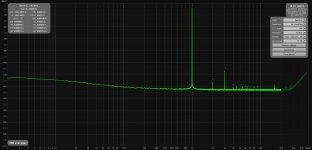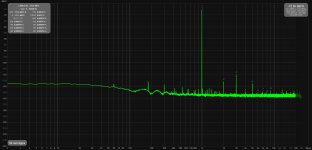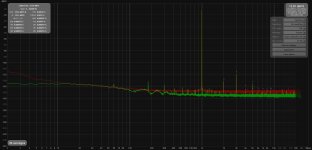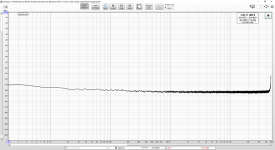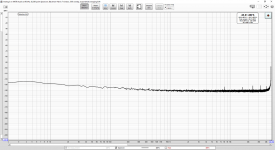Yes, just a TRS-TRS-cable from line output 4 to line input 4. Works that nice only with line input, the Mic input has a THD+N sweetspot of -12dBFS due to rising THD.That's impressive! is that really at the full output of 0dBfs=+16dBu?
Last edited:
It is a pity that line-inputs are accessible with windows only, with the latest Linux Kernels only the mic inputs are accessible. Luckily I have a win10 partition on one of my disks.Especially impressive for the total absence of mains spurs. That's rare.
Jan
I used a laptop disconnected from mains and the 30cm TRS-TRS patch cable. My wooden workbench is not ideal as it can sink capacitive current from hi-impedance un-shielded circuitry. Which adds to some 50Hz spur with my plastic boxed EMU-Tracker. No mains spurs with the metal case of the MOTU-M4. I choosed this soundcard after studying ASR reports and think this a very good bang for the buck actually.Especially impressive for the total absence of mains spurs. That's rare.
Jan
Last edited:
Just throwing this in...nothing to brag about. This is a Tascam US2x2HR, out > in. I replicated @bucks bunny settings, though I didn't capture the distortion settings, they are identical to his. Desktop machine Windoze machine, btw, using the Tascam ASIO driver.
The US2X2HR has a fairly hot output capability, goes to 7.75V, one of the few lower cost units that does, which is the reason I got it. I have an M2, 4Pre and the Quantassylum interface. If anyone's interested I can post the same tests later.
Out of curiosity, why the interest in such a low residual THD capability? What are we trying to test?

The US2X2HR has a fairly hot output capability, goes to 7.75V, one of the few lower cost units that does, which is the reason I got it. I have an M2, 4Pre and the Quantassylum interface. If anyone's interested I can post the same tests later.
Out of curiosity, why the interest in such a low residual THD capability? What are we trying to test?
I am trying to measure SINEAD of TPA3251 which meanwhile is better then my EMU-Tracker can resolve. And yes, your measurements are welcome.Just throwing this in...nothing to brag about. This is a Tascam US2x2HR, out > in. I replicated @bucks bunny settings, though I didn't capture the distortion settings, they are identical to his. Desktop machine Windoze machine, btw, using the Tascam ASIO driver.
The US2X2HR has a fairly hot output capability, goes to 7.75V, one of the few lower cost units that does, which is the reason I got it. I have an M2, 4Pre and the Quantassylum interface. If anyone's interested I can post the same tests later.
Out of curiosity, why the interest in such a low residual THD capability? What are we trying to test?
View attachment 1029046
For me I was testing a class AB power amp. It measures as low as 0.0003 @ 1w. Having the ability to measure such low THD and noise has shown me how critical layout is.
It may be advantageous to reduce sample rate to 44.1kHzHere's the US2X2, same settings, only adding 24 bit dither and...um...a few more averages. Turned on the 20kHz low pass too for a bit better noise figure.
Agreed. This taught me that in a typical AB-halfbridge a pos and neg halfwave must be summed - very precisely. If your measuring point is not exactly located at the feedback sense input, the perfect balance between both half waves deteriotes resulting in an asymmetric distortion term - that shows up in increasing H2, H4.... I know some people love this, but not me.For me I was testing a class AB power amp. It measures as low as 0.0003 @ 1w. Having the ability to measure such low THD and noise has shown me how critical layout is.
OK, got it. Design tweaks. Makes sense. Just asking because at the levels shown everything is so far below audibility.
Yes, but the filter works too. It's just a noise issue, noise always rises with frequency, especially above 20kHz. Pretty much true of every interface I have at least.It may be advantageous to reduce sample rate to 44.1kHz
Just tried it, changing from 96kHz with the 20kHz distortion LPF in to 44.1kHz with no filter returned identical results both in noise and distortion. N=105.2dB.It may be advantageous to reduce sample rate to 44.1kHz
Here's the QA401 initerface with REW, same distortion settings as before. Note there's a 6dB increase at the input due to the way the QA401 handles differential inputs. The spurs below 1KHz are always there, not distortion products.
Also attached, a lay-over of the US2X2 and QA401. Green is the 401. It's mostly a noise advantage.
The QA401 was discontinued in 2020, the current version is QA403, stock suffering from the silicon shortage. It has better THD and noise than either the QA402 or QA401. I got my 401 just weeks before the 402 release (I was not informed!). Might be an upgrade in the offing sometime this year. In many ways I prefer REW to their free software, but it's better in some ways too.
Also attached, a lay-over of the US2X2 and QA401. Green is the 401. It's mostly a noise advantage.
The QA401 was discontinued in 2020, the current version is QA403, stock suffering from the silicon shortage. It has better THD and noise than either the QA402 or QA401. I got my 401 just weeks before the 402 release (I was not informed!). Might be an upgrade in the offing sometime this year. In many ways I prefer REW to their free software, but it's better in some ways too.
Attachments
is it using the same computer/power supply? battery? Mains? Usually a balanced connection is pretty clean under the fundamentalHere's the QA401 initerface with REW, same distortion settings as before. Note there's a 6dB increase at the input due to the way the QA401 handles differential inputs. The spurs below 1KHz are always there, not distortion products.
Also attached, a lay-over of the US2X2 and QA401. Green is the 401. It's mostly a noise advantage.
The QA401 was discontinued in 2020, the current version is QA403, stock suffering from the silicon shortage. It has better THD and noise than either the QA402 or QA401. I got my 401 just weeks before the 402 release (I was not informed!). Might be an upgrade in the offing sometime this year. In many ways I prefer REW to their free software, but it's better in some ways too.
Yes, nothing changed but the interface. Mains, it's a desktop.is it using the same computer/power supply? battery? Mains? Usually a balanced connection is pretty clean under the fundamental
I don't know about the Quantum asylum stuff but it looks like mains leakage. It's USB powered right?
"Heavy duty USB cable. The QA401 can consume up to 600 mA or so. While lighter gauge (skinny) USB cables can be used, it's possible the skinny USB cable will have too much voltage drop on some USB ports--and this can raise the noise floor of the QA401. Ideally, you want to find a USB 2.0 Male to B Male cable with 24AWG power conductors."
"Heavy duty USB cable. The QA401 can consume up to 600 mA or so. While lighter gauge (skinny) USB cables can be used, it's possible the skinny USB cable will have too much voltage drop on some USB ports--and this can raise the noise floor of the QA401. Ideally, you want to find a USB 2.0 Male to B Male cable with 24AWG power conductors."
I came across this thread a few weeks ago. I have built speaker systems, and also built amplifiers (tube and solid state) and was searching for a means of evaluating performance. I was inspired to purchase an external USB sound interface so that I would have the option of being portable with a laptop. I also wanted something with much better performance than any built-in sound card could offer. I ultimately ended-up buying a used Motu UltraLite-Mk3-Hybrid at a good price. It's about 5 years old, so the specs are not quite as good as the latest stuff, but it's still excellent. I have attached 3 RTA screen shots from REW. The first is just monitoring the input with nothing plugged-in. The second is with a loop-back cable from the selected output to the input, and the third is using the loopback cable feeding the built-in signal generator of REW set on a 1KHz sine wave. I'm pretty sure I've got a good solid setup now. You'll notice that once the loopback cable was used, there are spikes starting at 8KHz and multiples upwards. I'm not sure what that is, but it seems sufficiently low to not be a problem. All were set to 96KHz sample rate.
Attachments
Perhaps use coherent averaging and a suitable window and FFT length to better view the harmonics. You may want to lower the fundamental frequency a bit so that it doesn't visually align with your 8kHz spike. You may find that 8kHz spike and its harmonics relate to an internal smps, or alternatively a nearby smps.
- Home
- Design & Build
- Software Tools
- How to - Distortion Measurements with REW
